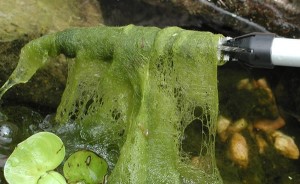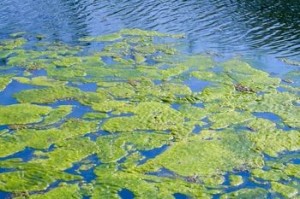Algae Everywhere!!! What do I do?!
Algae! Blech!
The number one question we get in this business is: “My pond is full of algae, how do I get rid of it?”. That is a very good question and don’t be afraid to ask it, but don’t call the algae “moss” or we may laugh at you. The answer is simple, but at the same time complicated. The simple part of the answer is that the best way to get rid of algae is to create a balance in your pond with fish, plants, and other critters so that the algae doesn’t have so much sunlight and nutrients in the water that it takes over the whole pond. Achieving that balance can be the complicated part, so make a bathroom run, wash your hands please, get a sandwich, and let’s get started.
Right off I should distinguish between two very general types of algae that plague ponds. They are: stringy algae (a.k.a. blanket weed, filamentous algae, hair algae, moss <snicker>, string algae, and many more. Yes, I know there are many actual types and scientific names for them, but this is not a science journal, so get over it.), and unicellular algae (a.k.a. green water, pea soup). The stringy algae grows attached to almost everything in the pond, while the unicellular algae is simply free floating algae particles. Occasionally stringy algae will get thick enough that it will form mats on the surface of the water, hence the name “blanket weed”. Green water is usually the first algae problem customers will have, and it is not at all unusual for a brand new pond to go through a phase of murky water before things come into balance. Green water is also the easier of the two types to control.
I have had customers tell me that they bought plants from a certain water garden store and that those <expletive> plants put algae in their pond so they will never go back to that <expletive> store ever again! Even as much as I would like for them to come to my shop and forsake all others I feel obliged to tell them that algae can come from a whole lot of places, and is almost inevitable, but only if the conditions are poor will the algae go crazy. There are algae spores in tap water, in the air, in the digestive tracts of fish and birds, on many of the rocks around the pond, and of course on the plants, but if you maintain a balance in the pond then there is no reason to fear algae taking over, regardless of where it came from. Also, algae is not necessarily a bad thing. Having some algae in the pond is part of a normal, healthy ecosystem, but you just don’t want it to take over.
Once you add water to your pond then you have added the first thing algae needs to grow. The other two things it needs are sunlight and nutrients in the water. So to control algae you take away or limit these things. How do you that, you ask? Well, you can’t get rid of the water of course, but one way you can control sunlight is by using water lilies and other surface covering plants. Here in the southwest where the sun is intense I usually recommend surface coverage of 60 to 70 percent. I know that sounds like a lot, but it makes for a beautiful water garden, and there are plenty of places for the fish to show up. I personally enjoy a pond more when I get glimpses of different beautiful fish swimming in and out of the plants than a pond where the fish are always right in front of you as if it were a fish bowl.
Early in the season especially, before the plants really take off you could also consider the blue or black pond dyes. They are often referred to as liquid shade. I can’t say I particularly love the look of a blue pond personally, but it is a matter of taste and many water gardeners do like the look of it. It is usually much nicer to have a translucent blue pond than a murky green pond. If you ever attend a theme park or amusement park you will usually notice a very liberal use of pond tint. A couple of other options for controlling sunlight on the water garden is the use of shade structures near or over the pond or by strategically placing tall plants in areas where they can throw shade on the rest of the pond. Also, when building your pond, if it isn’t already too late, try to avoid gently sloping sides or shelves that get hit with lots of sunlight. These often become algae gardens and are not much fun to slip on when you are getting in or out of the pond, and yes I know that from personal experience.
Controlling nutrients in the pond water is the second part of obtaining a balanced pond, and arguably the most important part (Again, I use the term “nutrients” as a very general term to cover nitrates, potassium, phosphates and many other trace elements. If I’m not being scientific enough for you then I’m sure there is an old Star Trek rerun somewhere you could be watching). The primary method for removing nutrients from the water is by using desired water plants (as opposed to algae, that is not desired) to use up the nutrients and basically out-compete the algae for the nutrients in the water. Floating plants such as water hyacinth or water lettuce do a very nice job, with their roots dangling down into the water. Anacharis, hornwort, Cabomba and Vallisneria are often referred to as “filtering grasses” since they are able to pull nutrients directly in through their leaves, as opposed to just through their roots like most plants. Any marginal plants (cattails, Louisiana iris, rushes, reeds, etc), especially as they develop large root systems will pull some nutrients from the water as well. Simply placing the plants into the pond in pots, or planting them into built-in bog areas in the pond helps tremendously, but pushing the water through the roots of the plants is even more beneficial.
The fish and other little buddies is the next part of the equation. Goldfish, snails (certain types), tadpoles, and other types of fish will eat some stringy algae and can help to keep it down. Do not over feed your fish, since fish food left in the water can break down and encourage algae blooms. If you get a stringy algae bloom and keep a pond with no koi in it you may be able to cut back feedings and force the goldfish to eat more algae. The recommend maximum amount of fish in a pond is 1 inch of fish per 10 gallons of water. Do not overstock the pond, since the more fish and other life forms you add to the pond will add more nutrients to the water and it can be easy to throw the pond out of balance, causing an algae bloom. Also, keep in mind that those 1 inch fish you put into the pond are going to get bigger very and will add to the biological load of the pond as they grow.
That leads us into filtration. I have built and maintained ponds without any kind of filtration, or even pumps, and only used plants to balance the pond, but having a good filter makes the balance issue a whole lot easier to deal with. A good filter will pull extra debris out the water mechanically, and biologically or chemically remove many of the excess nutrients that are in the pond, completely taking them out of play. Filtration is a whole other article, or ten, but suffice to say that filtration can make your life a whole lot easier if it is done properly.
UV clarifiers are also awesome devices that absolutely work. A UV clarifier is a an ultraviolet light bulb that is housed in a tube, usually, and water is pushed or pulled through the tube thereby letting the light shine on the water as it goes by. A UV clarifier destroys any algae particles as they go by and thus clears the water of all unicellular algae particles. It doesn’t do much for stringy algae, since stringy algae is attached to things in the pond and won’t go past the bulb, but if you size the UV clarifier properly to the size of your pond and water pump then you can pretty much expect clear water. In the last few years ion generators have become more popular as well, and they work fine for controlling stringy algae, but since they give off low levels of copper and nickel into the water I don’t consider them safe for ponds containing fish over the long run.
Once again I have gone on too long. In upcoming articles I will talk about water treatments and using them appropriately for algae control and I will go over some of the filter types out there, both homemade and commercially made, plus I may write a very lengthy article about moss. Also if you have any questions or comments please let us know, since I’m truly not convinced anyone is reading any of this.

